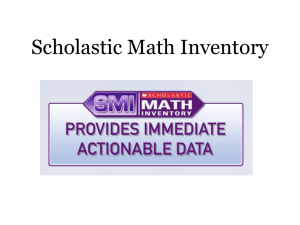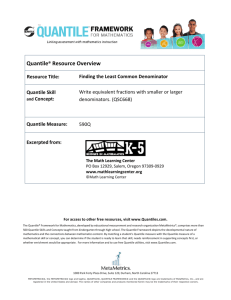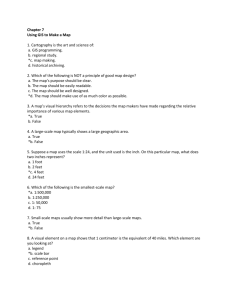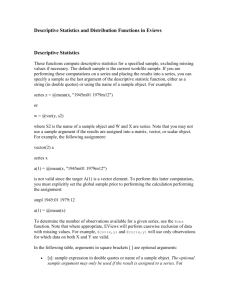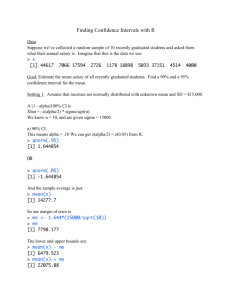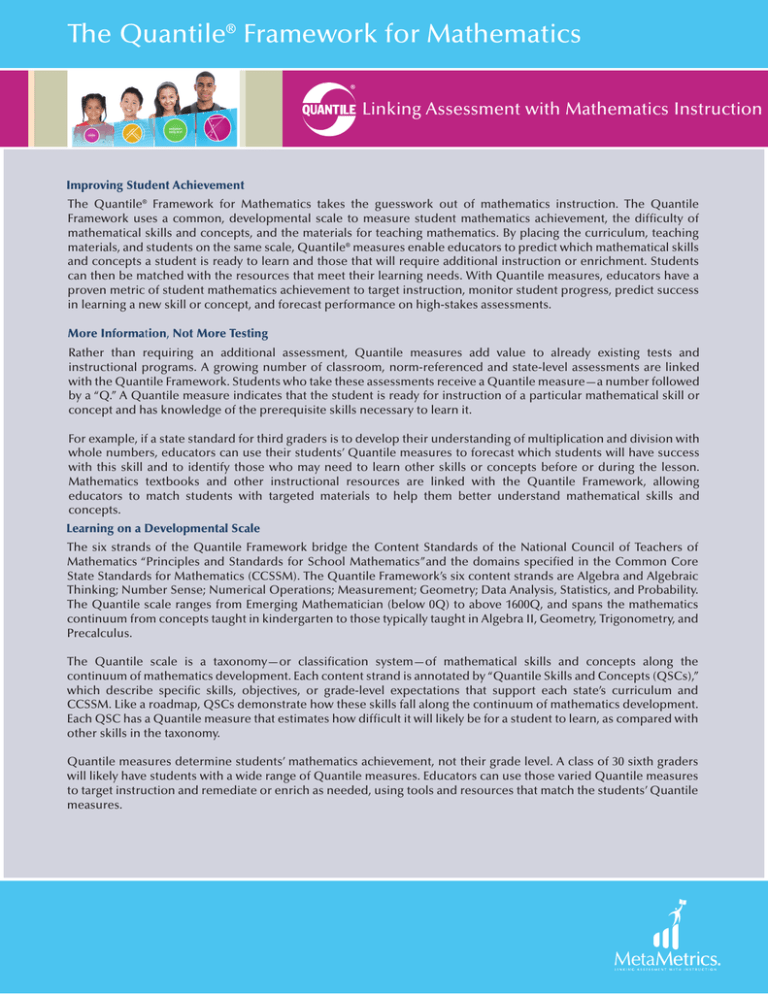
The Quantile® Framework for Mathematics
Linking Assessment with Mathematics Instruction
Improving Student Achievement
The Quantile® Framework for Mathematics takes the guesswork out of mathematics instruction. The Quantile
Framework uses a common, developmental scale to measure student mathematics achievement, the difficulty of
mathematical skills and concepts, and the materials for teaching mathematics. By placing the curriculum, teaching
materials, and students on the same scale, Quantile® measures enable educators to predict which mathematical skills
and concepts a student is ready to learn and those that will require additional instruction or enrichment. Students
can then be matched with the resources that meet their learning needs. With Quantile measures, educators have a
proven metric of student mathematics achievement to target instruction, monitor student progress, predict success
in learning a new skill or concept, and forecast performance on high-stakes assessments.
More Information, Not More Testing
Rather than requiring an additional assessment, Quantile measures add value to already existing tests and
instructional programs. A growing number of classroom, norm-referenced and state-level assessments are linked
with the Quantile Framework. Students who take these assessments receive a Quantile measure—a number followed
by a “Q.” A Quantile measure indicates that the student is ready for instruction of a particular mathematical skill or
concept and has knowledge of the prerequisite skills necessary to learn it.
For example, if a state standard for third graders is to develop their understanding of multiplication and division with
whole numbers, educators can use their students’ Quantile measures to forecast which students will have success
with this skill and to identify those who may need to learn other skills or concepts before or during the lesson.
Mathematics textbooks and other instructional resources are linked with the Quantile Framework, allowing
educators to match students with targeted materials to help them better understand mathematical skills and
concepts.
Learning on a Developmental Scale
The six strands of the Quantile Framework bridge the Content Standards of the National Council of Teachers of
Mathematics “Principles and Standards for School Mathematics”and the domains specified in the Common Core
State Standards for Mathematics (CCSSM). The Quantile Framework’s six content strands are Algebra and Algebraic
Thinking; Number Sense; Numerical Operations; Measurement; Geometry; Data Analysis, Statistics, and Probability.
The Quantile scale ranges from Emerging Mathematician (below 0Q) to above 1600Q, and spans the mathematics
continuum from concepts taught in kindergarten to those typically taught in Algebra II, Geometry, Trigonometry, and
Precalculus.
The Quantile scale is a taxonomy—or classification system—of mathematical skills and concepts along the
continuum of mathematics development. Each content strand is annotated by “Quantile Skills and Concepts (QSCs),”
which describe specific skills, objectives, or grade-level expectations that support each state’s curriculum and
CCSSM. Like a roadmap, QSCs demonstrate how these skills fall along the continuum of mathematics development.
Each QSC has a Quantile measure that estimates how difficult it will likely be for a student to learn, as compared with
other skills in the taxonomy.
Quantile measures determine students’ mathematics achievement, not their grade level. A class of 30 sixth graders
will likely have students with a wide range of Quantile measures. Educators can use those varied Quantile measures
to target instruction and remediate or enrich as needed, using tools and resources that match the students’ Quantile
measures.
The Quantile Framework for Mathematics
Using Quantile Measures to Support Mathematics Instruction
The Quantile website (www.Quantiles.com) offers educators and
parents a wealth of free resources for using Quantile measures to
support and simplify differentiated mathematics instruction.
On Quantiles.com, the Math Skills Database enables users to search
through the entire taxonomy of skills and concepts on the Quantile
scale to obtain their difficulty levels, resources, and specific state
curriculum alignments. Every teacher has the ability to search for a
concept using grade level state standards. Each state standard is
aligned to one or more QSCs so that the teacher can attain the
difficulty level of that skill or concept, as well as resources for the
material that can be used for classroom instruction. Resources, such as
mathematics textbooks, Web links, practice pages, math-literature
guides, black line masters, and games can be found through the search
features directly linked to mathematics standards by grade level. This
allows educators to match students with the instructional materials that
best meet their mathematics learning needs, which simplifies the
instructional planning process.
Educators also can use the Quantile Teacher Assistant on the website to
see how the Quantile range of the class compares with the Quantile
measure of the QSC being taught. Educators can access a variety of
resources that are aligned with their state standards to support
differentiated instruction based on each student’s mathematical ability.
The Quantile map, a graphic representation of the Quantile
Framework, also is available on the website. The map visually
illustrates mathematics development and the connections between
skills and concepts across the content strands.
MetaMetrics, an educational
measurement and research
organization, develops scientific
measures of student achievement that
link assessment with targeted
instruction to improve learning. The
organization’s psychometric team
developed the widely used Lexile
Framework for Reading; El Sistema
Lexile para Leer, the Spanish-language
version of the reading framework; The
Quantile Framework for Mathematics;
and The Lexile Framework for Writing.
In addition to licensing Lexile® and
Quantile measures to state departments
of education, testing and instructional
companies, and publishers, MetaMetrics
offers professional development,
resource measurement and
customized consulting services.
For more information on how
The Science Behind the Quantile Framework
Launched in 2004, the Quantile Framework was created by the
renowned psychometric team at MetaMetrics®, an educational
measurement and research organization. Based in part on the
organization’s more than 20 years of psychometric research, the
release of Quantile measures came after four years of development,
including an extensive national field study during the 2003–2004 school
year.
The Quantile Framework for
Mathematics can help to link
assessment with instruction and
improve student mathematics
achievement, call1–888–539–4537
or visit www.Quantiles.com.
MetaMetrics®, the MetaMetrics logo and tagline, Lexile®, Lexile® Framework, the Lexile logo, Quantile®, Quantile®
Framework and the Quantile logo are trademarks of MetaMetrics, Inc., and are registered in the United States
and abroad. The trademarks and names of other companies and products mentioned herein are the property of
their respective owners. Copyright © 2014 MetaMetrics, Inc. All rights reserved.
1000 Park Forty Plaza Drive, Suite 120
Durham, North Carolina 27713
919–547–3400/1–888–539–4537
www.Quantiles.com



